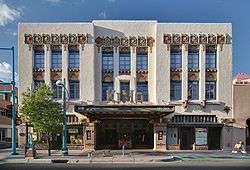KiMo Theater
|
Kimo Theatre | |
 | |
| Location | 423 Central Avenue NW, Albuquerque, New Mexico |
|---|---|
| Coordinates | 35°5′5.99″N 106°39′7.11″W / 35.0849972°N 106.6519750°WCoordinates: 35°5′5.99″N 106°39′7.11″W / 35.0849972°N 106.6519750°W |
| Built | 1927 |
| Architect | Boller Brothers; Carl Boller |
| Architectural style | Pueblo Deco |
| NRHP reference # | 77000920[1] |
| NMSRCP # | 453 |
| Significant dates | |
| Added to NRHP | May 2, 1977 |
| Designated NMSRCP | July 30, 1976[2] |
The KiMo Theatre is a theatre and historic landmark located in Albuquerque, New Mexico on the northeast corner of Central Avenue and Fifth Street. It was built in 1927 in the extravagant Art Deco-Pueblo Revival Style architecture, which is a blend of adobe building styles (rounded corners and edges), decorative motifs from indigenous cultures, and the soaring lines and linear repetition found in American Art Deco architecture.[3]
History
The KiMo was conceived by entrepreneur Oreste Bachechi and his wife, Maria Franceschi Bachechi. It was Mrs. Bachechi's desire to give a tribute to the Native Americans who had embraced the Bachechi family as part of their own. After much travel and meetings with various architects in both NM and California, the design was accepted from Carl Boller of the Boller Brothers architecture firm, who conducted an extensive investigation into the cultures and building styles of the Southwest before submitting his design. The theater is a three-story stucco building with the stepped massing characteristic of native pueblo architecture, as well as the recessed spandrels and strong vertical thrust of Art Deco skyscrapers. Both the exterior and interior of the building incorporate a variety of indigenous motifs, like the row of terra cotta shields above the third-floor windows.
The name "KiMo" (literally translated as "mountain lion" in Tewa, and sometimes loosely translated as "king of the beasts") was suggested to Mrs. Bachechi by her dear friend, Isleta Pueblo Governor Pablo Abeita,.[4]
By 1977, the theater had fallen into disrepair due to a fire. The City of Albuquerque offered to purchase the building at a fraction of its value or condemn it and then demolish it. The family decided that it was best to preserve the theater for future generations and sold the theater to the City of Albuquerque. It has undergone several phases of continuing restoration to return it to its former glory and is once again open to the public for performances. The most recent preservation was completed in 2000 with the installation of new seating and carpet, main stage curtain, new tech booth, lighting positions hid between and behind "vigas" on the ceiling, and a re-creation of the KiMo's original proscenium arch. The auditorium seating capacity was 650 at completion of the restoration.[5]
Legends
According to local legend, the KiMo Theatre is haunted by the ghost of Robbie Darnall, a six-year-old boy killed in 1951 when a water heater in the theater's lobby exploded. The tale alleges that a theatrical performance of A Christmas Carol in 1974 was disrupted by the ghost, who was supposedly angry that the staff was ordered to remove donuts they'd hung on backstage pipes to appease him.[6][7]
While investigating the legend, writer Benjamin Radford discovered that A Christmas Carol was not performed at the theater until 1986, and no disruptions were reported. According to Radford, "all the evidence points to an inescapable conclusion: the ruination of the play - the very genesis of the KiMo Theater ghost story - simply did not occur; it is but folklore and fiction". Radford also contacted Robbie Darnall's siblings, who told him they felt "exploited by the story" and did not appreciate "claims that their beloved brother is continuing to eat stale doughnuts and ruin performances at the KiMo Theater".[8][9]
Gallery
- Interior of the KiMo theater.
- KiMo technician Dennis Potter shows investigator Benjamin Radford the site of a 1951 explosion which spurred a ghost story.
- Shrine at the KiMo theater where, by tradition, cast and crew leave offerings for the resident boy ghost.
 Interior of the theatre
Interior of the theatre- Theater detail
References
- ↑ National Park Service (2007-01-23). "National Register Information System". National Register of Historic Places. National Park Service.
- ↑ "New Mexico State and National Registers". New Mexico Historic Preservation Commission. Retrieved 2013-03-13.
- ↑ For examples of this style of building, see Marcus Whiffen, Pueblo Deco: The Art Deco Architecture of the Southwest ( ISBN 0-8263-0676-4).
- ↑ Breeze, Carla, Pueblo Deco, New York: Rizzoli, 1990, p. 54
- ↑ "Information about restoration efforts of the KiMo". City of Albuquerque. City of Albuquerque. Retrieved 8 March 2018.
- ↑ Alan Brown (19 September 2016). Haunted Southwest. Arcadia Publishing Incorporated. pp. 36–. ISBN 978-1-4396-5871-0.
- ↑ Burnham, Acacia; Guerrero, Diego. "New Mexico: State of spooks". SantaFeNewMexican.com. The Santa Fe New Mexican. Retrieved 8 March 2018.
- ↑ Ghosts, Doughnuts, and A Christmas Carol: Investigating New Mexico’s ‘Haunted’ KiMo Theater by Ben Radford on csicop.org
- ↑ Benjamin Radford (15 August 2014). Mysterious New Mexico: Miracles, Magic, and Monsters in the Land of Enchantment. University of New Mexico Press. ISBN 978-0-8263-5452-5.
External links
![]()
- The KiMo Theatre (City of Albuquerque Website)
- The KiMo Theatre's 'ghost' page (City of Albuquerque Website)